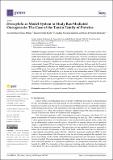Por favor, use este identificador para citar o enlazar a este item:
http://hdl.handle.net/10261/341807COMPARTIR / EXPORTAR:
 SHARE SHARE
 CORE
BASE CORE
BASE
|
|
| Visualizar otros formatos: MARC | Dublin Core | RDF | ORE | MODS | METS | DIDL | DATACITE | |

| Título: | Drosophila as Model System to Study Ras-Mediated Oncogenesis: The Case of the Tensin Family of Proteins |
Autor: | Martínez-Abarca Millán, Ana; Soler Beatty, Jennifer CSIC ORCID; Valencia-Expósito, Andrea CSIC ORCID; Martín-Bermudo, María D. CSIC ORCID | Palabras clave: | Oncogenic Ras Overgrowth Tensins Drosophila |
Fecha de publicación: | 2023 | Editor: | Multidisciplinary Digital Publishing Institute | Citación: | Genes 14(7): 502 (2023) | Resumen: | Oncogenic mutations in the small GTPase Ras contribute to ~30% of human cancers. However, tissue growth induced by oncogenic Ras is restrained by the induction of cellular senescence, and additional mutations are required to induce tumor progression. Therefore, identifying cooperating cancer genes is of paramount importance. Recently, the tensin family of focal adhesion proteins, TNS1-4, have emerged as regulators of carcinogenesis, yet their role in cancer appears somewhat controversial. Around 90% of human cancers are of epithelial origin. We have used the Drosophila wing imaginal disc epithelium as a model system to gain insight into the roles of two orthologs of human TNS2 and 4, blistery (by) and PVRAP, in epithelial cancer progression. We have generated null mutations in PVRAP and found that, as is the case for by and mammalian tensins, PVRAP mutants are viable. We have also found that elimination of either PVRAP or by potentiates RasV12-mediated wing disc hyperplasia. Furthermore, our results have unraveled a mechanism by which tensins may limit Ras oncogenic capacity, the regulation of cell shape and growth. These results demonstrate that Drosophila tensins behave as suppressors of Ras-driven tissue hyperplasia, suggesting that the roles of tensins as modulators of cancer progression might be evolutionarily conserved. | Versión del editor: | http://dx.doi.org/10.3390/genes14071502 | URI: | http://hdl.handle.net/10261/341807 | DOI: | 10.3390/genes14071502 | Identificadores: | e-issn: 2073-4425 |
| Aparece en las colecciones: | (CABD) Artículos |
Ficheros en este ítem:
| Fichero | Descripción | Tamaño | Formato | |
|---|---|---|---|---|
| Drosophila as Model System_Martínez_PV_Art2023.pdf | 8,29 MB | Adobe PDF |  Visualizar/Abrir |
CORE Recommender
Page view(s)
7
checked on 12-may-2024
Download(s)
7
checked on 12-may-2024
Google ScholarTM
Check
Altmetric
Altmetric
Este item está licenciado bajo una Licencia Creative Commons

